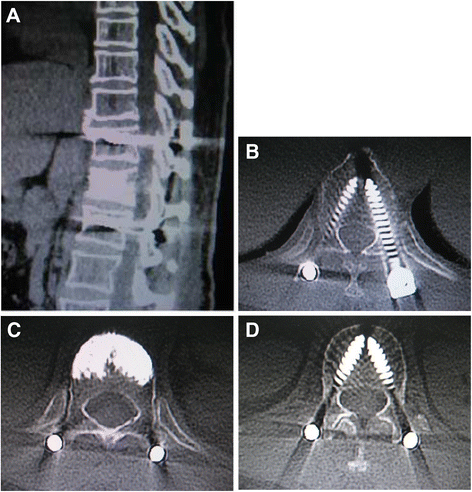Minimally invasive pedicle screw fixation combined with percutaneous vertebroplasty for preventing secondary fracture after vertebroplasty
- PMID: 25890296
- PMCID: PMC4352555
- DOI: 10.1186/s13018-015-0172-1
Minimally invasive pedicle screw fixation combined with percutaneous vertebroplasty for preventing secondary fracture after vertebroplasty
Abstract
Background: Percutaneous vertebroplasty (PVP) and percutaneous kyphoplasty (PKP) could give rise to excellent outcomes and significant improvements in pain, analgesic requirements, function, cost, and incidence of serious complications for thoracolumbar osteoporotic vertebral compression fractures (VCFs). But some studies showed the recurrent fracture of a previously operated vertebra or adjacent vertebral fracture after PVP or PKP. The purpose of this study was to compare minimally invasive pedicle screw fixation (MIPS) and PVP with PVP to evaluate its feasibility and safety for treating acute thoracolumbar osteoporotic VCF and preventing the secondary VCF after PVP.
Methods: Sixty-eight patients with a mean age of 74.5 years (ranging 65 ~ 87 years), who sustained thoracic or lumbar fresh osteoporotic VCFs without neurologic deficits underwent the procedure of PVP (group 1, n = 37) or MIPS combined with PVP (group 2, n = 31). Visual analog scale pain scores (VAS) were recorded and Cobb angles, central and anterior vertebral body height were measured on the lateral radiographs before surgery and immediately, 1 month, 2 months, 3 months, 6 months, 1 year, and 2 years after surgery.
Results: The patients were followed for an average of 27 months (ranging 24-32 months). The VAS significantly decreased after surgery in both groups (P < 0.005). The central and anterior vertebral body height significantly increased (P < 0.005), and the Cobb angle significantly decreased (P < 0.05) immediately after surgery in both groups. No significant changes in both the Cobb angle correction and the vertebral body height gains obtained were observed at the end of the follow-up period in group 2. But the Cobb angle significantly increased (P < 0.005), and the central and anterior vertebral body height significantly decreased (P < 0.005) 2 years after surgery compared with those immediately after surgery in group 1, and there were five patients with new fracture of operated vertebrae and nine cases with fracture of adjacent vertebrae.
Conclusions: MIPS combined with PVP is a good choice for the treatment of acute thoracolumbar osteoporotic VCF, which can prevent secondary VCF after PVP.
Figures






References
-
- McKiernan F, Faciszewski T, Jensen R. Quality of life following vertebroplasty. J Bone Joint Surg Am. 2004;86:2600–6. - PubMed
-
- Garfin SR, Buckley RA, Ledlie J. Balloon kyphoplasty for symptomatic vertebral body compression fractures results in rapid, significant, and sustained improvements in back pain, function, and quality of life for elderly patients. Spine. 2006;31:2213–20. doi: 10.1097/01.brs.0000232803.71640.ba. - DOI - PubMed
Publication types
MeSH terms
LinkOut - more resources
Full Text Sources
Other Literature Sources
Medical

